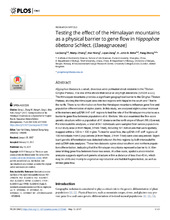| dc.contributor.author | La, Qiong | |
| dc.contributor.author | Zhang, W. | |
| dc.contributor.author | Wang, H. | |
| dc.contributor.author | Zeng, L | |
| dc.contributor.author | Birks, Harry John Betteley | |
| dc.contributor.author | Zhong, Yang | |
| dc.date.accessioned | 2017-09-22T13:26:31Z | |
| dc.date.available | 2017-09-22T13:26:31Z | |
| dc.date.issued | 2017-05-10 | |
| dc.Published | La Q, Zhang W, Wang H, Zeng L, Birks HJB, Zhong Y. Testing the effect of the Himalayan mountains as a physical barrier to gene flow in Hippophae tibetana Sachlect. (Elaeagnaceae). PLoS ONE. 2017;12(5): e0172948 | eng |
| dc.identifier.issn | 1932-6203 | en_US |
| dc.identifier.uri | https://hdl.handle.net/1956/16724 | |
| dc.description.abstract | Hippophae tibetana is a small, dioecious wind-pollinated shrub endemic to the Tibetan-Qinghai Plateau. It is one of the shrubs that occur at very high elevations (5250 m a.s.l.). The Himalayan mountains provides a significant geographical barrier to the Qinghai-Tibetan Plateau, dividing the Himalayan area into two regions with Nepal to the south and Tibet to the north. There is no information on how the Himalayan mountains influence gene flow and population differentiation of alpine plants. In this study, we analyzed eight nuclear microsatellite markers and cpDNA trnT-trnF regions to test the role of the Himalayan mountains as a barrier to gene flow between populations of H. tibetana. We also examined the fine-scale genetic structure within a population of H. tibetana on the north slope of Mount (Mt.) Everest. For microsatellite analyses, a total of 241 individuals were sampled from seven populations in our study area (4 from Nepal, 3 from Tibet), including 121 individuals that were spatially mapped within a 100 m × 100 m plot. To test for seed flow, the cpDNA trnT-trnF regions of 100 individuals from 6 populations (4 from Nepal, 2 from Tibet) were also sequenced. Significant genetic differentiation was detected between the two regions by both microsatellite and cpDNA data analyses. These two datasets agree about southern and northern population differentiation, indicating that the Himalayan mountains represent a barrier to H. tibetana limiting gene flow between these two areas. At a fine scale, spatial autocorrelation analysis suggests significant genetic structure within a distance of less than 45 m, which may be attributed mainly to vegetative reproduction and habitat fragmentation, as well as limited gene flow. | en_US |
| dc.language.iso | eng | eng |
| dc.publisher | PLoS | en_US |
| dc.rights | Attribution CC BY | eng |
| dc.rights.uri | http://creativecommons.org/licenses/by/4.0/ | eng |
| dc.title | Testing the effect of the Himalayan mountains as a physical barrier to gene flow in Hippophae tibetana Schlect. (Elaeagnaceae) | en_US |
| dc.type | Peer reviewed | |
| dc.type | Journal article | |
| dc.date.updated | 2017-09-12T13:48:46Z | |
| dc.description.version | publishedVersion | en_US |
| dc.rights.holder | Copyright 2017 Qiong et al. | en_US |
| dc.identifier.doi | https://doi.org/10.1371/journal.pone.0172948 | |
| dc.identifier.cristin | 1493098 | |
| dc.source.journal | PLoS ONE | |

